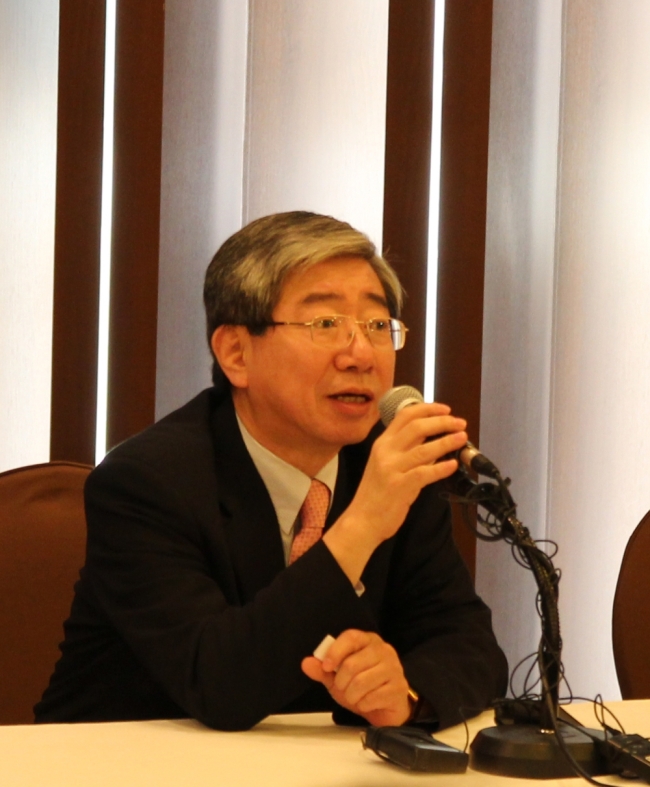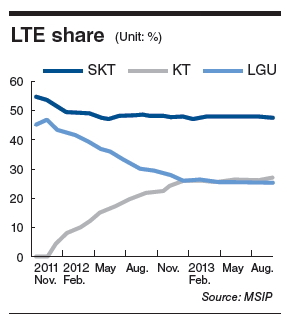Korea Mobile Internet ― a consortium consisting of mobile virtual network operators, IT services providers and financial backers ― recently said it was ready to become the country’s fourth telecommunications company and offer lower, competitive service rates for consumers amid an upsurge in mobile data traffic.
KMI seeks to provide such services through the Long Term Evolution Time-Division Duplex networks.
This is the consortium’s fifth attempt at winning the license to operate as a mobile carrier.
But it remains to be seen whether KMI stands a chance against SK Telecom, KT and LG Uplus, Korea’s three established telecom companies, in the competitive high-speed wireless market.
“The telecommunications market is already too saturated for any newcomers to enter. Plus, it will be difficult for KMI to offer cheaper and quality services with little network operational experience,” said Yang Seung-woo, an analyst at Samsung Securities.
The government also reiterated firmly that it would not issue a license unless the consortium has enough capital to finance its mobile communication venture. Fundraising had been the main problem for KMI, which now says it is no longer an issue.
KMI CEO Kong Jong-ryeol refuted such negative outlooks.
KMI seeks to provide such services through the Long Term Evolution Time-Division Duplex networks.
This is the consortium’s fifth attempt at winning the license to operate as a mobile carrier.
But it remains to be seen whether KMI stands a chance against SK Telecom, KT and LG Uplus, Korea’s three established telecom companies, in the competitive high-speed wireless market.
“The telecommunications market is already too saturated for any newcomers to enter. Plus, it will be difficult for KMI to offer cheaper and quality services with little network operational experience,” said Yang Seung-woo, an analyst at Samsung Securities.
The government also reiterated firmly that it would not issue a license unless the consortium has enough capital to finance its mobile communication venture. Fundraising had been the main problem for KMI, which now says it is no longer an issue.
KMI CEO Kong Jong-ryeol refuted such negative outlooks.

“As the Internet of Things expands, data traffic is expected to double in five years,” Kong told The Korea Herald in a telephone interview.
“There will be room for us to operate and grow amid this forecast and as the government plans to add additional bandwidths to accommodate a rapid increase in Long Term Evolution network subscribers.”
He is confident that KMI’s rates will be 30 percent lower than those currently offered by the three existing carriers.
The government decided last September to allow LTE-TDD, an LTE variant, for a potential new telecom operator, while forgoing homegrown Wireless Broadband, which has lagged behind the 4G technology.
Although LTE-Frequency Division Duplex is more globally used now, the trend has been shifting as China Mobile, China’s biggest wireless provider with 700 million subscribers, began to use LTE-TDD.

“Unlike the three local telecom companies’ LTE-FDD, with fixed communication lanes for voice and data, LTE-TDD lanes are flexible. As consumers increasingly use data over voice, LTE-TDD lanes can fully be used for data,” KMI CEO Kong said.
“We also do not have to spend much on network maintenance as we will only be using LTE-TDD.”
Other telecom operators are spending on 2G, 3G and 4G LTE networks as they still have subscribers for those networks. Maintenance of each network costs around 400 billion won ($375 million) per year.
The KMI CEO said that the company expects to attract around 8.6 million subscribers, or 15 percent of total users, in five years once it launches.
KMI, which passed its first evaluation last month, would need to have more than 60 out of 100 points in terms of capability in telecommunications services, technology and user protection plans.
KMI will be able to provide services in April after passing its second evaluation early next month, CEO Kong said.
By Shin Ji-hye (shinjh@heraldcorp.com)







![[KH Explains] How should Korea adjust its trade defenses against Chinese EVs?](http://res.heraldm.com/phpwas/restmb_idxmake.php?idx=644&simg=/content/image/2024/04/15/20240415050562_0.jpg&u=20240415144419)











![[Today’s K-pop] Stray Kids to return soon: report](http://res.heraldm.com/phpwas/restmb_idxmake.php?idx=642&simg=/content/image/2024/04/16/20240416050713_0.jpg&u=)